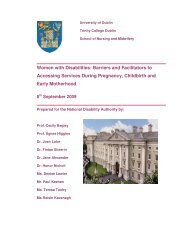Literature Review on Provision of Appropriate and Accessible ...
Literature Review on Provision of Appropriate and Accessible ...
Literature Review on Provision of Appropriate and Accessible ...
Create successful ePaper yourself
Turn your PDF publications into a flip-book with our unique Google optimized e-Paper software.
PAGE 31<br />
1.7 Heterogeneity<br />
People with intellectual disabilities are not a separate, homogeneous<br />
group <strong>of</strong> human beings who think, feel <strong>and</strong> act in a similar fashi<strong>on</strong>. Their<br />
individual likes, dislikes, choices, talents, strengths <strong>and</strong> weaknesses are<br />
varied, as elsewhere in society (Ontario Ministry <strong>of</strong> the Attorney General,<br />
2005). Intellectual <strong>and</strong> adaptive functi<strong>on</strong>ing <strong>of</strong> people with intellectual<br />
disability varies widely, hence, so does their capacity to functi<strong>on</strong><br />
independently (Schalock <strong>and</strong> Luckass<strong>on</strong>, 2004). The variati<strong>on</strong> between<br />
different individuals within the same group cannot be overstated (Murphy<br />
<strong>and</strong> Clare, 2003). For example, the overwhelming majority <strong>of</strong> people with<br />
intellectual disabilities have difficulties that are subtle <strong>and</strong> are not easily<br />
recognised (Emers<strong>on</strong>, Hatt<strong>on</strong>, Felce <strong>and</strong> Murphy, 2000). Only a very small<br />
proporti<strong>on</strong> is unlikely to be able to use verbal language or to carry out<br />
simple tasks <strong>of</strong> everyday living (such as eating, washing <strong>and</strong> dressing)<br />
without support (Hogg <strong>and</strong> Seba, 1986). This heterogeneity must be<br />
c<strong>on</strong>sidered when deciding the relevance <strong>of</strong> general statements about<br />
people with intellectual disabilities.<br />
Support to People with an Intellectual Disability who are<br />
<strong>Accessible</strong><br />
<strong>and</strong> <strong>Appropriate</strong> <strong>of</strong> Provisi<strong>on</strong> <strong>on</strong> <str<strong>on</strong>g>Review</str<strong>on</strong>g> <str<strong>on</strong>g>Literature</str<strong>on</strong>g><br />
Experiencing Crisis Pregnancy<br />
1.8 Level <strong>of</strong> disability<br />
Research that has been carried out <strong>on</strong> sexuality <strong>and</strong> women with<br />
intellectual disabilities has for the most part neglected to include<br />
c<strong>on</strong>siderati<strong>on</strong> <strong>of</strong> the sexual needs <strong>and</strong> feelings <strong>of</strong> women with more<br />
severe disabilities (Downs & Craft, 1997). Historically, it was c<strong>on</strong>sidered<br />
that the severity <strong>of</strong> such women’s disabilities would override all <strong>and</strong><br />
any aspects <strong>of</strong> their sexuality. According to McCarthy (2002), for most<br />
people with intellectual disabilities, it is the case that a pr<strong>of</strong>ound<br />
intellectual impairment <strong>and</strong> the associated life-l<strong>on</strong>g dependency <strong>on</strong><br />
others means that they are unlikely to be in a positi<strong>on</strong> to engage in<br />
c<strong>on</strong>senting sexual relati<strong>on</strong>ships with other people. Underst<strong>and</strong>ing<br />
sexuality in its wider form, though, including ‘feelings <strong>of</strong> love <strong>and</strong><br />
sexual arousal, underst<strong>and</strong>ing what touch does <strong>and</strong> does not give<br />
pleasure, masturbati<strong>on</strong>, sexual health, self-awareness <strong>and</strong> selfimage,<br />
identity, communicati<strong>on</strong>, pers<strong>on</strong>al development, gender issues<br />
<strong>and</strong> age appropriateness’ are relevant for people with pr<strong>of</strong>ound <strong>and</strong><br />
multiple disabilities as they are for other people (McCarthy, 2002:<br />
92). The research that has been carried out for the most part relates<br />
to the heterosexual experiences <strong>of</strong> mainly white women with mild
















